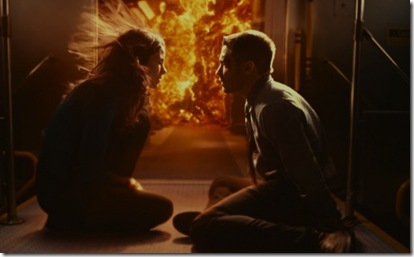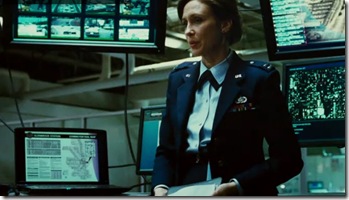Suppose you could stop a nuclear attack on a major American city – but only by reliving the last eight minutes of someone else’s life and with no idea of where you were when you were not in that other, soon-to-end life. That’s the situation in which Jake Gyllenhaal’s Captain Colter Stevens finds himself in, in Duncan Jones’ Source Code.
A man [Gyllenhaal] awakens on a train. Opposite, a beautiful woman [Michelle Monaghan] is speaking to him like they’re old pals. He has no idea where he is, or who she might be. When the weirdness is too much for him, he bolts for the washroom and finds himself looking at a stranger in its mirror. He opens his wallet and finds idea belonging to ‘Sean Ferris – Teacher.’ Then everything explodes and he regains consciousness in some kind of pod – to the entreaties of a cool blonde in military dress who informs him he is back in ‘Beleaguered Castle.’
The last thing he remembers before awakening on the train is being a helicopter pilot on a mission in Afghanistan. The blonde identifies herself as Captain Goodwin [Vera Famiga] and tells him he needs to go back to the train and figure out who bombed it. If he fails, a much bigger bomb will be set off in Chicago.
The rest of the film bounces between Stevens’ attempts to figure out who the bomber is and his brief interludes at Beleaguered Castle, trying to get Stevens, or her boss, Dr. Rutledge [Jeffrey Wright], to explain just what the hell is going on. On the train, he gets to know the beautiful woman – Christina – and in Beleaguered Castle, he slowly begins to make a dent in the cool Goodwin’s emotional armor.
The science in source code may be shaky, but it’s an interesting concept – a specific kind of operative can be inserted into the last eight minutes of a person’s memory before they die. Rutledge likens it to being shunted into parallel realities, though he claims that isn’t, quite, what it is. Stevens has the good/misfortune to fir the exact parameters of an operative to take on missions in these situations – enabled by something Rutledge calls the source code.
I’m sure you’ll hear a lot of comparisons between Source Code and Groundhog Day and they are completely valid in terms of both having to revisit a specific time period over and over in order to make things right, and in terms the emotional journey made by the protagonists of each film.
Director Duncan Jones [Moon], who also co-wrote the script [with Ben Ripley], likes to play with big ideas, though not at the expense of well-defined, realistic characters. So while the train hurtles toward Chicago and explodes – over and over again – there are more layers besides the boy-meets-girl stuff, or the science fictional element.
If the only time someone can be brave is when they are afraid, then Stevens is brave man. While not entirely bereft of identity or emotions, he has no idea where he is or what happened to his unit back in Afghanistan. He doesn’t know if his father, with whom he had fought before beginning his last tour of duty, has any idea of his whereabouts. He has no idea if what Captain Goodwin is telling him is true – or if Rutledge is feeding him a bill of goods. He doesn’t even have control over whether he gets sent back in the last minutes of Sean Ferris’ memory.
Of course, strength of character/bravery isn’t the only other layer here. As Stevens returns to the doomed train again and again, he takes closer notice of the people on the train. In spite of his lack of knowledge on one plane, he adds it on others. He also opens up emotionally, in a way he hasn’t done in years, with Christina.
In spite of all the things he doesn’t know, he determines to carry on. If they’re telling the truth, he might save two million lives – and if Dr. Rutledge’s analogy is more accurate than he says, he might even save the people on the train – at least in one reality. Who knows? He might even get the girl.
Jones directs Source Code in a manner that suggests an ever tightening spiral, using helicopter shots and cutting back and forth between the train and Chicago as the film opens, making us feel tension and a subtle claustrophobia that we don’t even recognize until Stevens finally gains consciousness back at Beleaguered Castle.
From then on, the film builds tension even more rapidly, using small events to ramp up the movement of time – spilt coffee, punched tickets, a phone ringing. All the while, the film circles from train to Beleaguered Castle; each circuit adding to Stevens’ knowledge of both the train and his situation in that pod.
As the film moves to its seemingly inevitable conclusion, it also becomes apparent that evil isn’t always a crazy person with a bomb – sometimes, it’s the guy with the big idea – or those who fund him. We also see that courage isn’t always the domain of the warrior.
Gyllenhaal is brilliant as Stevens. Even in the craziest situations, he makes Stevens – as confused and scared as he is – believable as someone who can think things through. And his growing attachment to Christina is entirely believable – though that wouldn’t work as well if Monaghan wasn’t as good an actor as she is [and the two have terrific chemistry].
In terms of character transformation, though, an equally important piece of the film’s overall puzzle is the change that occurs within Captain Goodwin. It may be a quieter evolution, but Farmiga manages the difficult task of transformation without seeming change. To outward appearances, Goodwin is much the same as when we first meet her. It’s only in the last moments of the film that we see how much she’s changed – even though Farmiga has brought us with her so subtly, we are not surprised by her actions.
Source Code might fall apart if you play too hard with the science, but it’s a story that engages and delights because as much as it’s about saving the world – or, at least, Chicago – it’s about desperate people finding their way. It has that in common with Jones’ first film, Moon. It’s also really, really good. It has that in common with Moon, too.
Final Grade: A+


“Source Code” is a time travel movie about a military experiment that allows someone to go back and control the actions of someone else. There is about to be a catastrophic attack on Chicago and it is hoped that this experiment can prevent it. Unfortunately, the gimmick gets tiresome.
GRADE = “C”